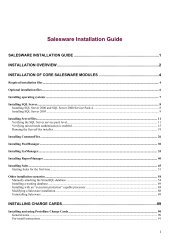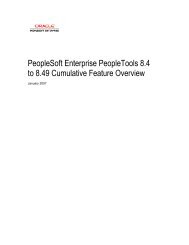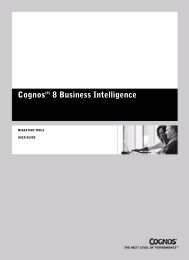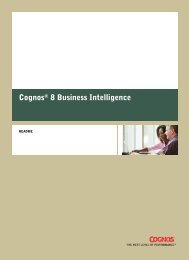COGNOS Business Intelligence Series 7
pes.pdf
pes.pdf
You also want an ePaper? Increase the reach of your titles
YUMPU automatically turns print PDFs into web optimized ePapers that Google loves.
Chapter 3: Control Processes<br />
2. From the Edit menu, click Properties, and then click the Settings tab.<br />
3. In the Maximum Processes box (Process Control), type the number of processes.<br />
4. If you have defined mirror references and want to give processing preferences to the local<br />
source in order to queue requests rather than forward them to the mirror reference, type the<br />
number of requests to queue (beyond the maximum) in the Local Process Threshold box.<br />
5. Click OK.<br />
Tips<br />
• If, after adjusting the number of processes, you determine that more processing power is<br />
required, you can use mirror references to process remotely, or you may need to upgrade your<br />
computing resources.<br />
Limit the Processing Time<br />
You can set an absolute time limit that the query or report processor spends on any request.<br />
Adjusting this timeout may be useful for cases of "runaway" queries that would otherwise<br />
consume up to 15 minutes (the default) of processor time.<br />
Steps<br />
1. In PowerPlay Enterprise - Server Administration, select a cube or report.<br />
2. From the Edit menu, click Properties, and then click the Settings tab.<br />
3. In the Request Timeout box (Process Control), type the number of seconds.<br />
4. Click OK.<br />
Tips<br />
• This setting applies to all requests submitted by all users. Setting it too low may result in a<br />
high number of query or report failures.<br />
Configure How Windows Processes are Scheduled<br />
As a new request is received from a PowerPlay Windows application, there may be a delay before<br />
that request gets processed by a query processor (if it is busy). For any cube, you can choose how<br />
to distribute requests based on how busy each processor is, by setting a threshold to control the<br />
load balancing for these requests.<br />
The setting represents a ratio of delay time to active processing time.<br />
• A value of 0 means no delay, so each request is submitted to the first available processor,<br />
similar to the way Web requests are handled.<br />
• A value from 1 to 9 means each request is submitted to the next processor whose ratio of<br />
delay time to processing time is lower than the number specified. For example, a value of 5<br />
means each request is submitted to the first processor that has less than a 50% ratio of delay<br />
time to processing time.<br />
• A value of 10 means each request is submitted to the next processor in sequence, regardless of<br />
the load on that processor.<br />
Steps<br />
1. In PowerPlay Enterprise - Server Administration, select a cube.<br />
2. From the Edit menu, click Properties, and then click the Settings tab.<br />
3. In the Scheduling Threshold(s) box (Process Control), type a number from 0 to 10.<br />
4. Click OK.<br />
Stop Processing Requests<br />
You can disable a PowerPlay server, folder, or individual cubes or reports to temporarily prevent<br />
the processor from accepting requests. This is useful, for example, when you have to replace a<br />
cube or report, or perform maintenance on several items at once. You can also use this feature to<br />
stop any runaway processes.<br />
34 Cognos PowerPlay (R)
















